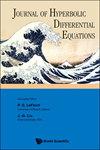标量守恒定律下粘性激波的l2型收缩
IF 1.1
4区 数学
Q4 MATHEMATICS, APPLIED
引用次数: 0
摘要
研究了具有均匀凸通量和非线性耗散的一维标量粘性守恒律的小激波。我们证明这样的冲击是稳定的,与耗散强度无关,即使有大的扰动。利用空间非齐次伪范数的相对熵方法进行证明。本文章由计算机程序翻译,如有差异,请以英文原文为准。
L2-type contraction of viscous shocks for scalar conservation laws
We study small shocks of 1D scalar viscous conservation laws with uniformly convex flux and nonlinear dissipation. We show that such shocks are [Formula: see text] stable independently of the strength of the dissipation, even with large perturbations. The proof uses the relative entropy method with a spatially-inhomogeneous pseudo-norm.
求助全文
通过发布文献求助,成功后即可免费获取论文全文。
去求助
来源期刊

Journal of Hyperbolic Differential Equations
数学-物理:数学物理
CiteScore
1.10
自引率
0.00%
发文量
15
审稿时长
24 months
期刊介绍:
This journal publishes original research papers on nonlinear hyperbolic problems and related topics, of mathematical and/or physical interest. Specifically, it invites papers on the theory and numerical analysis of hyperbolic conservation laws and of hyperbolic partial differential equations arising in mathematical physics. The Journal welcomes contributions in:
Theory of nonlinear hyperbolic systems of conservation laws, addressing the issues of well-posedness and qualitative behavior of solutions, in one or several space dimensions.
Hyperbolic differential equations of mathematical physics, such as the Einstein equations of general relativity, Dirac equations, Maxwell equations, relativistic fluid models, etc.
Lorentzian geometry, particularly global geometric and causal theoretic aspects of spacetimes satisfying the Einstein equations.
Nonlinear hyperbolic systems arising in continuum physics such as: hyperbolic models of fluid dynamics, mixed models of transonic flows, etc.
General problems that are dominated (but not exclusively driven) by finite speed phenomena, such as dissipative and dispersive perturbations of hyperbolic systems, and models from statistical mechanics and other probabilistic models relevant to the derivation of fluid dynamical equations.
Convergence analysis of numerical methods for hyperbolic equations: finite difference schemes, finite volumes schemes, etc.
 求助内容:
求助内容: 应助结果提醒方式:
应助结果提醒方式:


